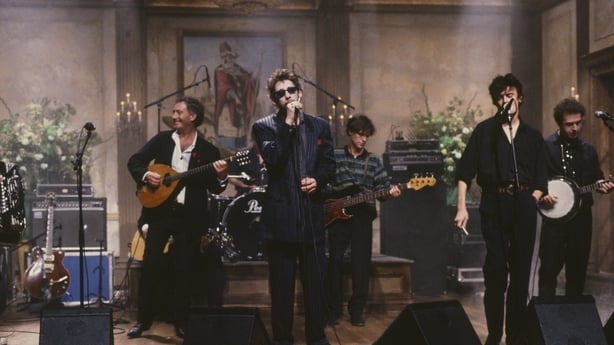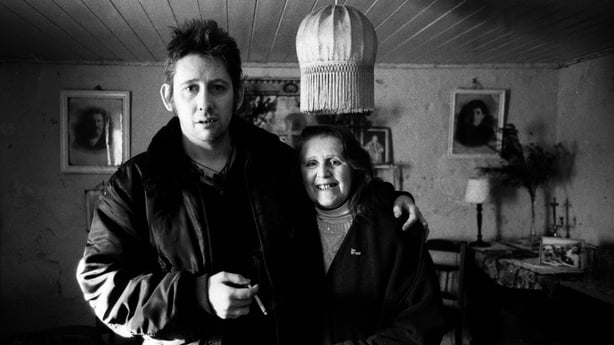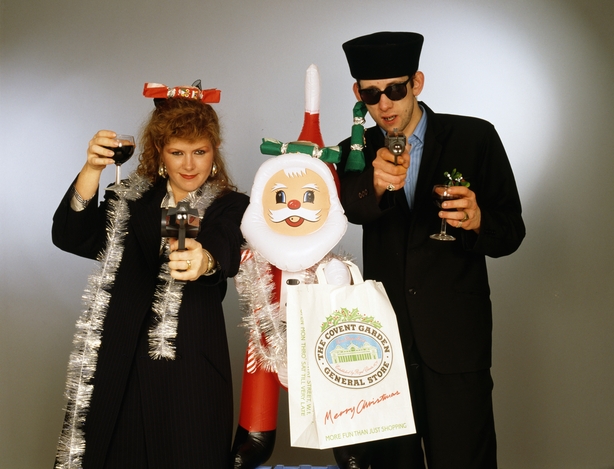Analysis: The Pogues' Christmas classic owes its iconic name to the work of Irish-American writer J.P. Donleavy.
"It was Christmas Eve babe / In the drunk tank" are the opening lyrics to one of the most instantly recognisable and loved Christmas songs. Fairytale of New York by The Pogues and featuring Kirsty McColl is about two lovers falling between the cracks of alcoholism and drug abuse at Christmas time and still finding love for each other, despite broken dreams and promises of Broadway stardom.
The Pogues' festive hit drew on the name of an earlier play and novel by Irish-American writer, J.P. Donleavy. Born in New York in 1926, Donleavy moved to Dublin in 1946 to take up studies at Trinity College Dublin. Aided by the G.I. scheme which assisted US army personnel in studying abroad, Donleavy's move to Dublin also coincided with his development as a writer and furthering connections within literary Dublin of the time.
The Pogues' Fairytale of New York
Donleavy's most famous novel The Ginger Man (1955) was banned and its stage adaptation was later also shut down at the Gaiety Theatre in 1959. Cuts to the script were demanded by the theatre’s manager, Louis Elliman, which were supported by the censorious eye of John Charles McQuaid, Archbishop of Dublin.
The story of any song, not least of all one as popular or as recognisable as Fairytale of New York, is rarely straight-forward. In this case, the song had numerous false-starts and early guises. Written by Jem Finer and the late Shane MacGowan, Fairytale of New York began as a planned Christmas song – what type of song was still to be decided.

Various accounts detail Elvis Costello urging the band to write a Christmas song, but not one with a 'jingle-jangle' of traditional Christmas fare. Through various iterations and recordings, the song took shape but lacked a title.
While "large amounts of drink and drugs accompanied the recording sessions at RAK studios" writes Richard Balls in his biography of MacGowan, Furious Devotion, "The Pogues were deadly serious about the music they made. As well as being an unforgettable and timeless song, Fairytale of New York was testament to their dedication to getting things right".

The song works and is loved by so many because it tells an affecting story, of people fighting to get up from being down and out, hoping on a lucky bet, but who are still filled with hope. People resonate with the lines "I can see a better time / When all our dreams come true", but they're not from the playbook of the typical Christmas ad campaigns that fill our screens annually and play on our heartstrings for emotional oomph. The characters relay the experience of many of Ireland's diaspora in the US and indeed elsewhere.
The search for a title for the song led to Donleavy's play. The original Fairytale tells the story of an ex-pat, the character of Cornelius Christian, who returns to his native New York from Europe. The play opens on the docks of West 57th Street, New York City and the "blasts of ships' whistles in the north river". The body of Christian's wife, who died during the ship's journey, is being unloaded by crane by the awaiting stevedores.
We need your consent to load this rte-player contentWe use rte-player to manage extra content that can set cookies on your device and collect data about your activity. Please review their details and accept them to load the content.Manage Preferences
From RTÉ News, Shane MacGowan (1957-2023) singer-songwriter and frontman of the band The Pogues dies aged 65
Less a traditional play driven by a single narrative, Donleavy's Fairy Tales is an interconnected series of scenes and sketches driven by the protagonist's wanderings through New York, trying and failing in finding gainful employment and meeting a host of characters on his comedic and farcical journey into work in a funeral home, trying his hand at preparing corpses. The work is not unlike a heightened Joycean episode.
TV presenter and author Bamber Gasgoigne wrote of Donleavy in 1963 that "the mind of the author is like a curved mirror in a funfair. Everything that passes before it takes on a new shape, distorted, yet still very recognisable".
We need your consent to load this rte-player contentWe use rte-player to manage extra content that can set cookies on your device and collect data about your activity. Please review their details and accept them to load the content.Manage Preferences
From RTÉ One's The Late Late Show, Shane MacGowan performs Fairytale of New York with his mother Therese
Fairytales of New York was first presented by Spur Productions and the Pembroke Theatre in Surrey, England on 6th December 1960, before transferring to the Comedy Theatre, London on 24th January 1961. Directed by Phillip Wiseman, the play included Harry Taub, Susan Hampshire, Robery Ayres and Barry Foster in the cast. The cast would all have long careers British theatre, TV and film. The renowned theatre critic Kenneth Tynan described the original 1960 production as being "a high comedy" by a "master of comic dialogue who is also a student of human eccentricity".
The play had its Irish debut in October 1971 at the Peacock studio space at the Abbey Theatre, Dublin. Joe Dowling directed the play, saying he was a fan of Donleavy since he had read the banned novel The Ginger Man while still in his teens in the late 1950s. Dowling added that he admired Donleavy's "brittle wit" [and] "economy of words, the skill with which he shows the relationships between his characters [in the play]".

John Kavanagh played Christian with the cast completed by Bryan Murray, Des Cave and Nuala Hayes. Bronwen Casson designed the set, which included a range of scenes from boxing matches to funeral parlours.
Writing in the Abbey show programme, Tomás Mac Anna outlined the complex humanity of New York City. From its low-falling winter sun to impossibly high offices overlooking a never sleeping city full of apartments, theatres, taxi-cabs, and wandering souls. "It is the rear-view mirror that tells the reality", he adds.
We need your consent to load this rte-player contentWe use rte-player to manage extra content that can set cookies on your device and collect data about your activity. Please review their details and accept them to load the content.Manage Preferences
From RTÉ Radio 1's Morning Ireland, Anthony Farrell from Liliput Press, pays tribute to JP Donleavy after the author and playwright's death in 2017
The play was later published as a novel in 1973 with the slightly changed title of A Fairy Tale of New York, and it was this book title which inspired the Pogues. The novel received more mixed reviews than the play did. A lengthy work at 400 pages, it perhaps lacked the comic pace and liveness, and admittedly, the slimness, of its theatrical counterpart.
Like the song, Fairy Tales of New York, and the novel that bears the name, are not heart-warming stories to wrap around like a Christmas hug. Instead they offer a story-telling of a different kind, a reminder that we are often separated from those we love by distance, by death, or by ending up in a drunk tank at Christmas. The reality is different from a fairy tale, there are no guarantees of a happy ending.
Follow RTÉ Brainstorm on WhatsApp and Instagram for more stories and updates
The views expressed here are those of the author and do not represent or reflect the views of RTÉ







